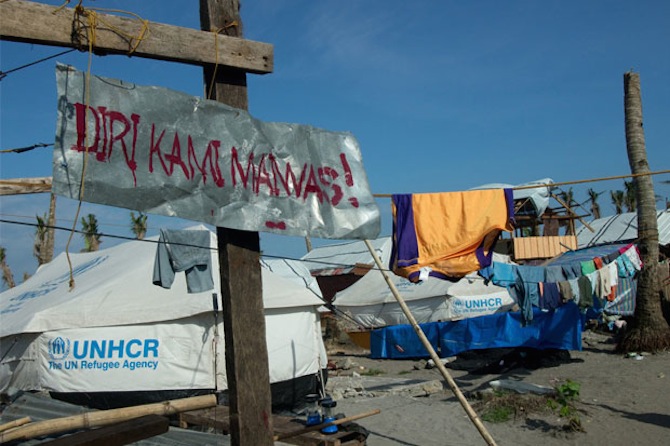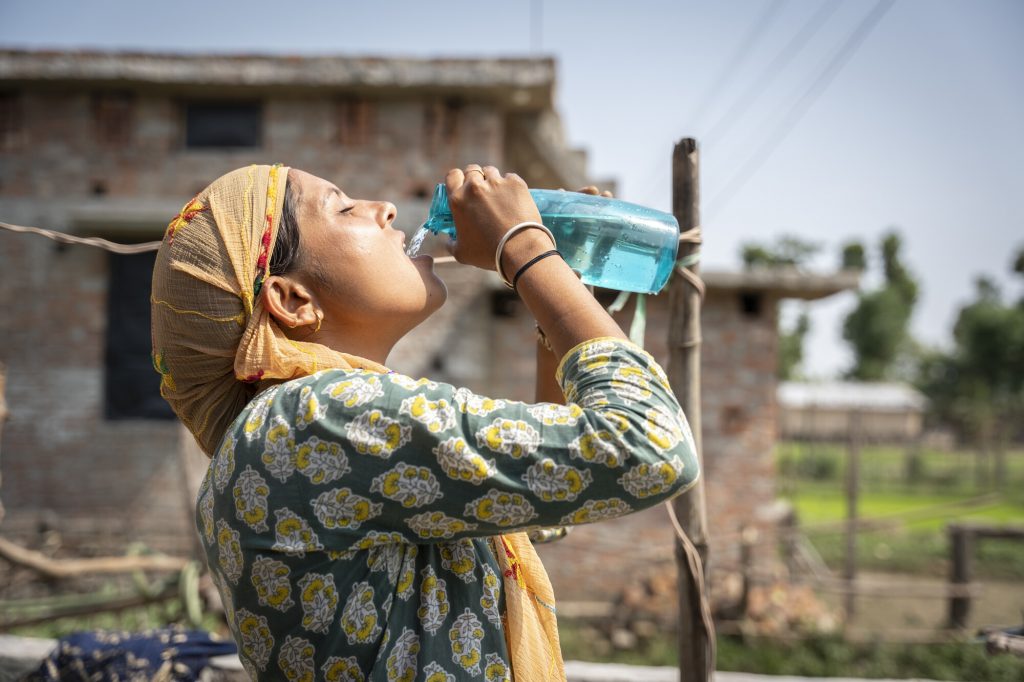After Haiyan – moving in the right direction?
by Caroline Gluck
When typhoon Haiyan hit the central Philippines last November, killing more than 6,000 people and destroying millions of people’s houses and livelihoods, people like fisherman Lionel Advincula, from Barangay Bislig in Tanauan municipality, Leyte province, found themselves having to make some tough choices.
One of the most pressing priorities for the father-of-nine was to find shelter and to rebuild his damaged house. It stood just 20 metres from the coast and was totally destroyed.
Moving away from seashore to be safe
“When we returned to our house, there was nothing left. It was like a desert. Everything had been washed away. Our boat was smashed to bits”, he recalled. But with no other land or options, Lionel was forced to fashion a temporary shelter, using corrugated iron, plastic tarpaulin and whatever else he could find. But several weeks afterwards, he and others in his village learnt that they would have to move once again because the government had announced a 40 metre “no-build” zone policy.
The idea is to move tens of thousands of people further away from the seashore to safer areas.
On paper, it makes good sense in a country which receives around 20 typhoons every year. In reality, a blanket 40 metre “no-build” zone is impractical and unrealistic.
In March the government back-tracked and announced it would instead do local hazard mapping and analysis to identify communities that will need to be relocated from areas deemed to be unsafe. Under the new guidelines, an estimated 200,000 people are now at risk of resettlement.
However, the practicality of giving people alternative land and housing, and ensuring people are properly consulted in the changes that will profoundly affect their lives, is still fraught with difficulties.
Life before the typhoon was already a struggle
Before the typhoon, life for Lionel was already a struggle. He used to fish with five others in a boat that is now completely destroyed. On a good day, he could earn around 500 pesos [about $11/£6]. On bad days, he’d come back empty handed.
Lionel, like many other people Oxfam interviewed in a survey of 453 individuals in three typhoon-hit provinces in Eastern Samar, Leyte and North Cebu, doesn’t object to moving – but only if he receives support from the government.
“If the government will provide us with more assistance or help us with some business support, I’ll agree to relocate because where we are living is dangerous and we are scared of living so close to the shoreline”, he said. “I saw the big waves during the typhoon and that terrified us.”
“My biggest fear is another typhoon. I’m afraid there will be another typhoon. And because we have not been relocated and properly re-housed, I feel very unsafe. The children cry when it rains and when storms come. They hide.”
But Lionel, like thousands of other people who may be resettled , has only heard rumours and small snippets of information about what relocation might involve.

And while he would like to live somewhere safer he also worries about where he might be re-housed, how far it will be located from the coast – and how that will affect his ability to return to fishing.
“I worry we will sink into poverty because our livelihoods haven’t been restored”, Lionel told me at a community meeting organized by Oxfam. “I have no work right now. I’m very worried, especially for my children because I don’t know how we’ll eat.”
Feeling confused and concerned about the relocation process
Many local government units are just as concerned about the relocation process. Limited budgets mean it’s hard for them to make the large-scale land purchases necessary to create permanent relocation sites. Some aren’t willing to hold consultation meetings with communities at an early stage, saying they are not fully aware of what their roles and responsibilities will be and that they don’t want to communicate incorrect information.
But that’s also leading to a lot of confusion and concern among populations who are likely to be affected by the policy.
81 per cent of people interviewed by Oxfam stated they are not aware of their rights regarding permanent relocation. Very few had received information about relocation, and only seven per cent of individuals interviewed said they have been consulted by a government official – at the government, municipal or barangay level – regarding the relocation process.
The worry is that not only does this deny people’s rights to basic information, it could also lead to failed relocations because communities have not been consulted and local authorities have not taken steps to understand and meet their expectations.
In the future, it could mean that the risks facing vulnerable populations might actually increase, rather than decrease, because of lack of political will, resources and planning. Rather than strengthening communities’ resilience to disasters, failing to take into account their concerns, including providing security of tenure and adequate livelihood opportunities, could actually make them more at-risk.
Caroline Gluck is Oxfam Great Britain Humanitarian Press Officer.
This blog originally appeared at blogs.oxfam.org
Related
 |
The Right Move Ensuring durable relocation after Typhoon Haiyan |

